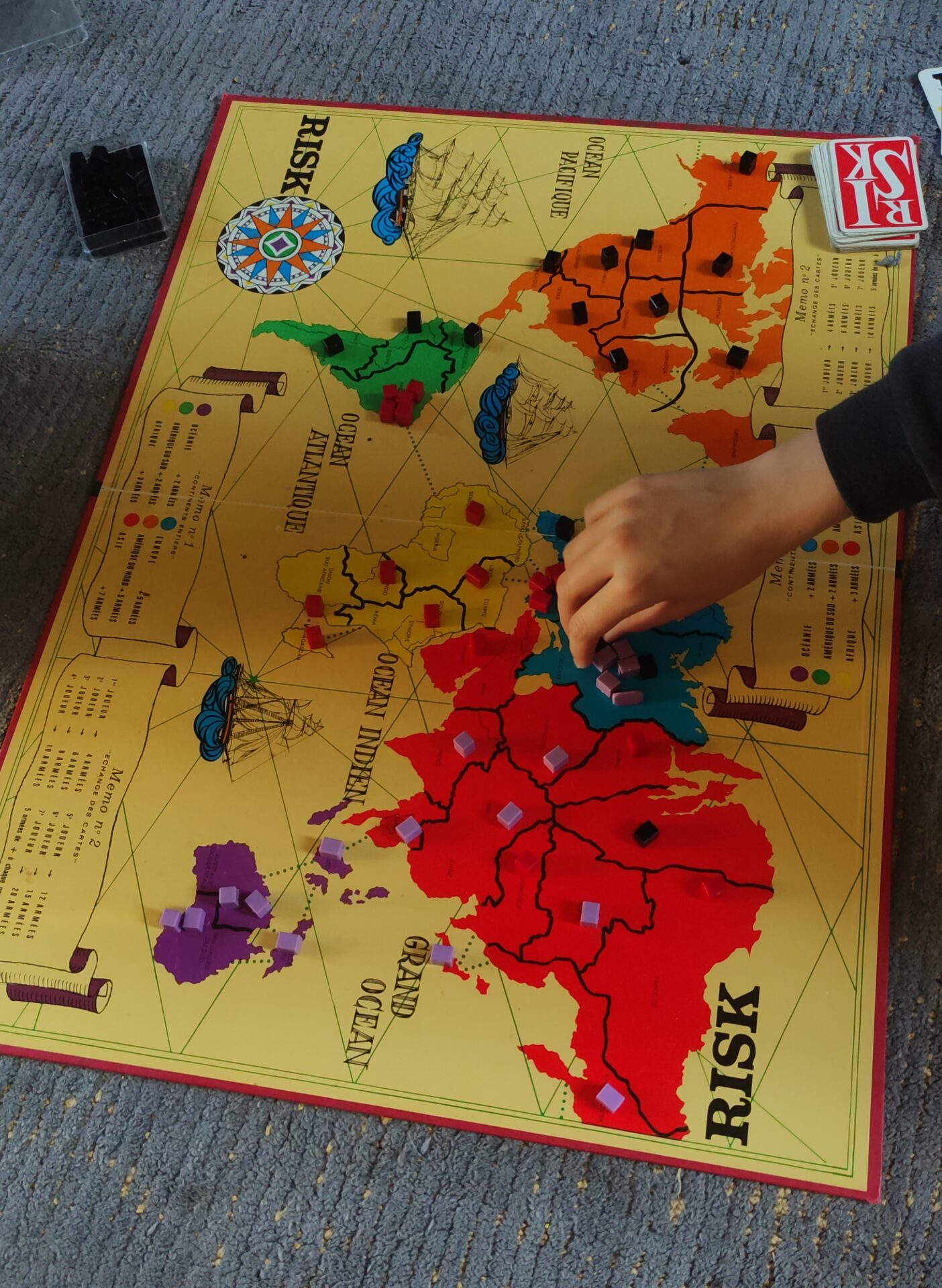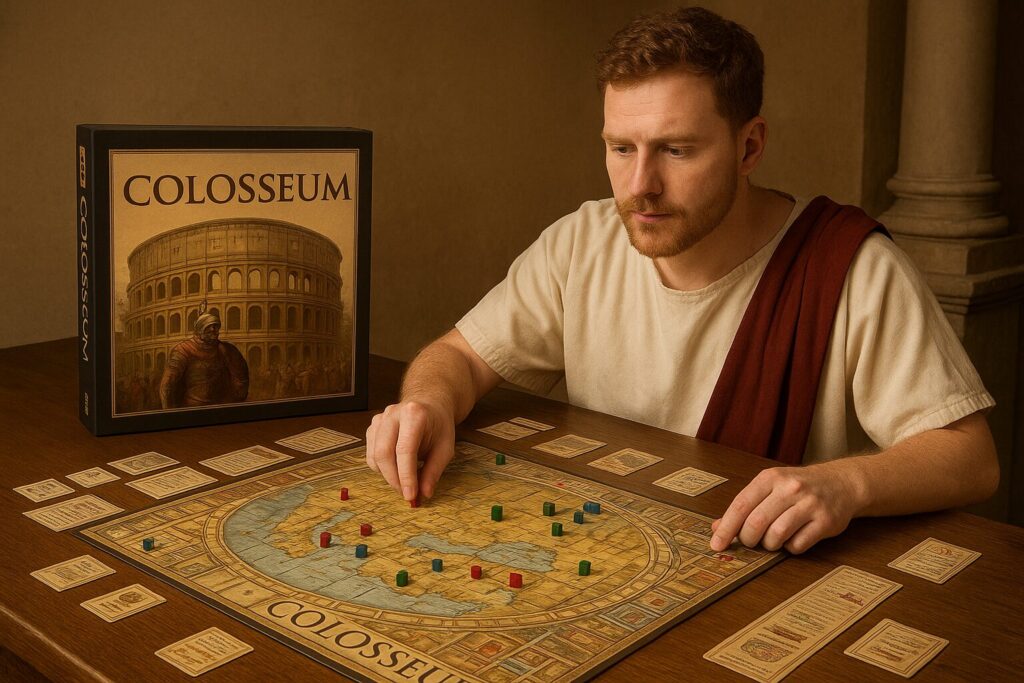Roman board games are another product of our fascination with their culture. Roman history has inspired more than just epic films, historical documentaries. Many people, including me, love to entertain themselves and to play games. Besides obvious video games, Rome became the setting for some of the most interesting board games ever made. So, what are Roman board games? Whether you’re picturing roaring crowds in the arena, the quiet manipulation of political rivals, or the grand logistics of running an empire, Rome’s world is tailor-made for storytelling.

This is Part 1 of our countdown of the Top 5 Roman Board Games. Maybe you will get some ideas to play with your friends and family, or maybe you will even get into conflict with some of them because of winning and losing.
5. Colosseum – Top 5 Roman Board Games
Designer: Wolfgang Kramer & Markus Lübke
Players: 3–5
Playtime: 60–90 minutes
Colosseum puts you in charge of producing spectacular shows in the heart of ancient Rome. Instead of commanding legions or passing laws, like in other Roman board games, your goal is to dazzle audiences with the most impressive events possible — gladiator battles, chariot races, theatrical performances, and exotic animal displays.
Each round, you’ll bid on event assets — performers, props, animals, and arenas — then arrange them into shows that will attract spectators and impress the Emperor. The trick lies in timing: certain assets are rarer than others, and rival producers are competing for the same talent and resources. Players must also manage upgrades to their arenas, as grander events require more space and prestige.
The game blends set collection, resource management, and tactical auctions. There’s a satisfying rhythm to starting with modest shows and working toward massive spectacles, with each round bringing opportunities for both bold plays and subtle sabotage. While there’s competition, the tone is lighter than in political or military games, making Colosseum perfect for a mixed group of casual and hobby gamers.
Replayability is high thanks to varied event cards and player strategies, and the colorful presentation captures the festive energy of Roman entertainment. This is Rome at its most flamboyant — less Senate scheming, more standing ovations.

4. Trajan – Top 5 Roman Board Games
Designer: Stefan Feld
Players: 2–4
Playtime: 90–120 minutes
While Colosseum focuses on spectacle, Trajan dives into the cerebral side of governance. Set during Emperor Trajan’s reign in 98–117 AD — a time of prosperity and expansion — the game challenges players to manage multiple aspects of Roman society simultaneously: politics, military campaigns, trade, and public works.
The heart of Trajan’s gameplay is its clever mancala-style action selection system. You have a circle of action spaces, each linked to specific tasks like building, trading, or influencing the Senate. On your turn, you move colored markers around this circle, and the space where they land determines your action. This creates a puzzle-like layer where every move sets up future possibilities — planning several turns ahead is essential.
You’re not only juggling immediate goals but also competing for points in several areas: constructing buildings, sending ships for trade, campaigning in distant provinces, and meeting the demands of the populace. There’s also the titular Trajan tiles, which grant special powers when you match marker colors correctly.
Trajan is pure Eurogame strategy — minimal direct conflict, maximum mental challenge. It rewards careful planning and offers countless paths to victory, making it a game you can return to again and again. It’s ideal for players who love optimization puzzles dressed in a richly thematic Roman setting.
3. The Republic of Rome – Top 5 Roman Board Games
Designer: Don Greenwood, Robert Haines, Richard Berthold
Players: 3–6
Playtime: 4–6+ hours
If you’re looking for the ultimate simulation of Roman political life, The Republic of Rome is unmatched. Originally published in 1990, this legendary game is as much a social experiment as it is a board game, capturing the constant push-and-pull between cooperation and betrayal that defined the Roman Senate.
Players control factions of senators, each with unique abilities, ambitions, and political weight. The Republic faces external threats — wars, rebellions, economic crises — that require collective action. Ignore them for too long, and Rome could collapse, causing everyone to lose. But while cooperation is necessary, only one faction can ultimately claim supremacy. This means every decision is loaded with double motives: help the state just enough to survive, but weaken rivals whenever possible.
Gameplay is driven by negotiation, voting, and event resolution. You’ll propose laws, command armies, manage provinces, prosecute rivals, and, if opportunity allows, orchestrate assassinations. The game’s historical flavor is rich — crises are drawn from real Roman events, and the balance of power can shift dramatically with a single vote.
The Republic of Rome is long, complex, and often hilariously treacherous. It’s best played with a group that enjoys political roleplay and can commit to an afternoon (or evening) of scheming. For those who want to truly feel the dangerous allure of Roman politics, this is the definitive experience. To be honest, this is my favorite board game. Not just my favorite among Roman board games, it is my favorite board game overall.

Hello, my name is Vladimir, and I am a part of the Roman-empire writing team.
I am a historian, and history is an integral part of my life.
To be honest, while I was in school, I didn’t like history so how did I end up studying it? Well, for that, I have to thank history-based strategy PC games. Thank you so much, Europa Universalis IV, and thank you, Medieval Total War.
Since games made me fall in love with history, I completed bachelor studies at Filozofski Fakultet Niš, a part of the University of Niš. My bachelor’s thesis was about Julis Caesar. Soon, I completed my master’s studies at the same university.
For years now, I have been working as a teacher in a local elementary school, but my passion for writing isn’t fulfilled, so I decided to pursue that ambition online. There were a few gigs, but most of them were not history-related.
Then I stumbled upon roman-empire.com, and now I am a part of something bigger. No, I am not a part of the ancient Roman Empire but of a creative writing team where I have the freedom to write about whatever I want. Yes, even about Star Wars. Stay tuned for that.
Anyway, I am better at writing about Rome than writing about me. But if you would like to contact me for any reason, you can do it at contact@roman-empire.net. Except for negative reviews, of course. 😀
Kind regards,
Vladimir
